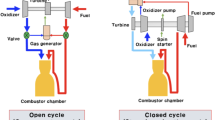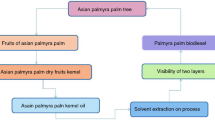Abstract
Since 2008, Institute of Aeronautics and Space (IAE) has made efforts into L75 Liquid Rocket Engine and a cooperation agreement was signed in 2011 with the Deutsches Zentrum für Luft—und Raumfahrt, the German Aerospace Center (DLR), aiming the L75 engine development. The achievement of adequate combustion stability was a major task, since the beginning. A novel methodology in stability studies regarding combustion stability of Lox/Ethanol propellant combination is proposed in this work. Basic studies and design investigations were performed, adopting a stability assessment strategy in two phases: First phase: L75 combustion chamber acoustics (frequencies and mode shapes) were obtained at room and hot temperatures by theoretical/experimental approaches. Second phase: two hot test campaigns were conducted at P8 test facility-DLR, with 21 hot tests. In 7 run-in tests, a Stainless Steel Capacitive cooled Thrust Chamber (SCTC) was used allowing burning up to 2 s. Instability phenomena were observed during pressure build up. Afterward, 14 tests were performed using Copper Cooled Thrust Chamber (CCTC) and no instability phenomena were observed, even at lower mass-flow then expected in test envelop (load point E6*) combined with low O/F ratios. CCTC allowed longer burning, increased up to 6 s. It is important to highlight that the burning times were calculated by using heat flux estimations at the SCTC/CCTC chamber throats to avoid damages in this critical region by steel/cooper melting. As the CCTC has better heat conductivity, longer burning times were established for this chamber. The measured data showed good agreement regarding the natural frequencies (and respective mode shapes), estimated in the first phase, indicating that the acoustic dynamics of the chamber was appropriately characterized.































Similar content being viewed by others
References
Blomshield FS (2001) Historical perspective of combustion instability in motors: case studies, AIAA/ASME/SAE/ASEE joint propulsion conference and exhibit, American & Astronautics. https://doi.org/10.2514/6.2001-3875
Huzel DK, Huang DH (1992) Modern Engineering For Design Of Liquid-Propellant Rocket Engines, American Institute of Aeronautics and Astronautics, Inc.
Combs LP, Oberg CL, Coutas TA, Evers WH (1974) Liquid rocket engine combustion stabilization devices. NASA Space Vehicle Design Criteria. SP-8113. November
Almeida DS, Pagliuco CMM (2014) Development status of L75: a Brazilian liquid propellant rocket engine. J Aerosp Technol Manag JATM 6(4):475–484. https://doi.org/10.5028/jatm.v6i4.386
Haeseler D, Götz A, Fröhlich A (2000) Non-toxic propellants for future advanced launcher propulsion system. AIAA-2000–3687, 36th AIAA/ASSME/SAE/ASEE Joint Propulsion Conference & Exhibit. Huntsville, AL. https://doi.org/10.2514/6.2000-3687
Levack DJH, Sack WF (2013) Development of the Bantam family of Aerojet Rocketdyne commercial rocket engines. AIAA-2013–4149, 49th AIAA/ASSME/SAE/ASEE Joint Propulsion Conference, San Jose, CA. https://doi.org/10.2514/6.2013-4149
Greene C, Claflin S, Mäding C, Butas J (1999) Non-toxic Orbital Maneuvering System engine development. AIAA-99–2742, 35th AIAA/ASSME/SAE/ASEE Joint propulsion conference & exhibit. Los Angeles, CA. https://doi.org/10.2514/6.1999-2742
Sieder J, Kleebusch K, Bach C, Tajmar M (2017) Development history of the flight model of a 500 N Ethanol/LOX rocket engine. In: 7th European conference for aeronautics and aerospace sciences (EUCASS). Milan, Italy. https://doi.org/10.13009/EUCASS2017-418
Krühsel G, and Schäfer K (2003) Design, development and evolution of an ethanol/lox injection hed for rocket steam generator of high flowrate. AIAA-2003–5044, 39th AIAA/ASSME/SAE/ASEE joint propulsion conference & exhibit. 20–23 July, Huntsville, AL
Schäfer K and Dommers M (2004) Alcohol lox steam generator test experience. In: 2nd international conference on green propellants for space propulsion, Cagliari, Sardinia, Italy, 7–8 June
Haeseler D, Bombelli V, Vuillermoz P, Lo R, Marée T, Caramelli F (2004) Green propellants propulsion concepts for space transportation and technology development needs. In: 2nd International conference on green propellants for space propulsion, Cagliari, Sardinia, Italy, 7–8 June
Krühsel G, and Schäfer K (2001) Design and development of an ethanol/lox injection head for rocket steam generator (50 kg/s steam) and experimental study of combustion stability, green propellant space propulsion 20 – 22 June, Noordwijk
Rubinsky VR (1995) Combustion Instability in the RD-0110 Engine. In: Yang V and Anderson W, Liquid rocket Engine Combustion Instability, Washingnton DC, AIAA, Progress in Astronautics and Aeronautics Series N. 169:89–112
Oefelein JC, Yang V (1993) Comprehensive review of liquid-propellant combustion instability in F-1 Engine. J Propul Power 9(5):657–677. https://doi.org/10.2514/3.23674
Natanzon MS, and Culick FEC (1999) Combustion Instability, Edited by California Institute of Technology
Kinsler LE, Frey AR, Coppens AB, Sanders JV (2000) Fundamentals of acoustics, 4th Edition, John Wiley and Sons, Inc.
Laudien E, Pongratz R, Pierro R, Preclick (1994) Experimental procedures aiding the design of acoustic cavities. In: Yang V, Anderson WE, Liquid rocket engine combustion instability. Washington, DC: AIAA – Progress in Aeronautics and Astronautics, 169, chap. 14, p. 377–399
Schulze M, Sattelmayer T (2017) Linear stability assessment of a cryogenic rocket engine. Int J Spray Combus Dyn 9(4):277–298. https://doi.org/10.1177/1756827717695281
Blevins RD (1995) Formulas for natural frequency and mode shape, 1st edn. Krieger Publishing Company, USA
Kessaev JV (1997) Theory and calculation of liquid-propellant engines, propellant liquid engine course notes, technological institute of aeronautics - ITA
Gordon S, Mcbride BJ (1994) Computer program for calculation of complex chemical equilibrium compositions and applications – I. Analysis, Cleveland, Ohio. National Aeronautics and Space Administration. NASA RP1311-Part 1
Mcbride BJ, Gordon S (1996) Computer program for calculation of complex chemical equilibrium compositions and applications – II. Users manual and program description, Cleveland, Ohio. National Aeronautics and Space Administration. NASA RP1311 - Part 2
Zienkiewicz OC (1977) The Finite Element Method - Vol. 1: Basic formulation and linear problems (McGraw-Hill, London)
Bathe K-J (1982) Finite element procedures in engineering analysis. Prentice Hall, Englewood Cliffs, New Jersey
Hughes TJR (1987) The finite element method : linear static and dynamic finite element analysis. Prentice Hall, Englewood Cliffs, New Jersey
Sohn CH, Park I-S, Kim S-K, Kim HJ (2007) Acoustic tuning of gas–liquid scheme injectors for acoustic damping in a combustion chamber of a liquid rocket engine. J Sound Vib 304:793–810. https://doi.org/10.1016/j.jsv.2007.03.036
Lioi C, Ku D, Yang V (2018) Linear acoustic analysis of main combustion chamber of an oxidizer-rich staged combustion engine. J Propul Power 34(6). https://doi.org/10.2514/1.B36878
Sohn CH, Cho HC (2004) Numerical analysis of acoustic characteristics in gas turbine combustor with spatial non-hogeneity. KSME Int J 18(8):1461–1469. https://doi.org/10.1007/BF02984259
Desmet W, Vandepite D (2001) Notes of the Grasmech course advanced acoustics. Katholieke Universiteit Leuven (KUL), Finite Elements On Acoustics
LMS QSources mid-frequency volume source user manual, LMS, Leuven, Belgium
Haberzettl A, Gundel D, Bahlmann K, Thomas JL, Kretschmer J, and Vuillermoz P (2000) European research and technology test bench P8 for high pressure liquid rocket propellants. In: Proceedings of the 36th AIAA/ASME/SAE/ASEE joint propulsion conference, Huntsville, Alabama, USA. https://doi.org/10.2514/6.2000-3307
Preuss A, Grauer F, Soller S, Preclik D (2009) 10 years of subscale testing at P8 test facility Lampoldshausen. In: Proceedings 3rd EUCASS conference, Versailles, France
Araújo LM, do Nascimento LB, de Souza BRD, Pagliuco CMM, de Almeida DS, and Dias IDB (2018) Comparison of transient and quasi steady state performances between full-scale and sub-scale thrust chambers of the L75 LOx-ethanol Rocket Engine. In: 2018 Joint Propulsion Conference, July 9-11, 2018, Cincinnati, Ohio. doi: https://doi.org/10.2514/6.2018-4945
Langel G, Laudien E, Pongratz R, Habiballah M, Grand-Perret S, Vingert L (1991) Combustion Stability Characteristics of the Ariane 5 L7 Engine. 42nd Congress of the International Astronautical Federation. Montreal, Canada. October
Sohn CH, Park JH (2011) A comparative study on acoustic damping induced by half-wave, quarter-wave, and Helmholtz resonators. Aerosp Sci Technol 15:606–614. https://doi.org/10.1016/j.ast.2010.12.004
Culick FE (2000) Combustion instabilities: mating the dance of chemical, combustion and combustor dynamics. In: 36th AIAA/ASME/SAE/ASEE joint propulsion, conference and exhibit, 16-19 July, Huntsville, Alabama. https://doi.org/10.2514/6.2000-3178
Acknowledgements
The German activities are supported by DLR with funds of the German Federal Ministry for Economic Affairs and Energy (references: 50 RL 1411 and 50 RL 1610).
IAE thanks the Brazilian Space Agency AEB for funding the L75 project and the support received from the National Council of Technological and Scientific Development—CNPq (Process 400938/2014-6).
The authors also would like to thank DLR Institute of Space Propulsion in Lampoldshausen for the support, especially for welcoming guest scientists from Brazil and for the high level of commitment of the P8 operator team and Ariane Group test team during the test campaigns.
Author information
Authors and Affiliations
Corresponding author
Additional information
Technical Editor: André Cavalieri.
Publisher's Note
Springer Nature remains neutral with regard to jurisdictional claims in published maps and institutional affiliations.
Rights and permissions
About this article
Cite this article
Pirk, R., Souto, C.d., Almeida, D.S. et al. Stability assessment of L75 lox-ethanol rocket engine. J Braz. Soc. Mech. Sci. Eng. 43, 487 (2021). https://doi.org/10.1007/s40430-021-03175-2
Received:
Accepted:
Published:
DOI: https://doi.org/10.1007/s40430-021-03175-2




